February 1, 2010
By Pamela J. Waterman
CFD analysis brings its own type of power to the renewable energy push, replicating and predicting results for systems that tap the wind, rivers, oceans, sun, and fuel cells. DE takes a look at applications in each of these realms and examines why specific software has proven invaluable for success.
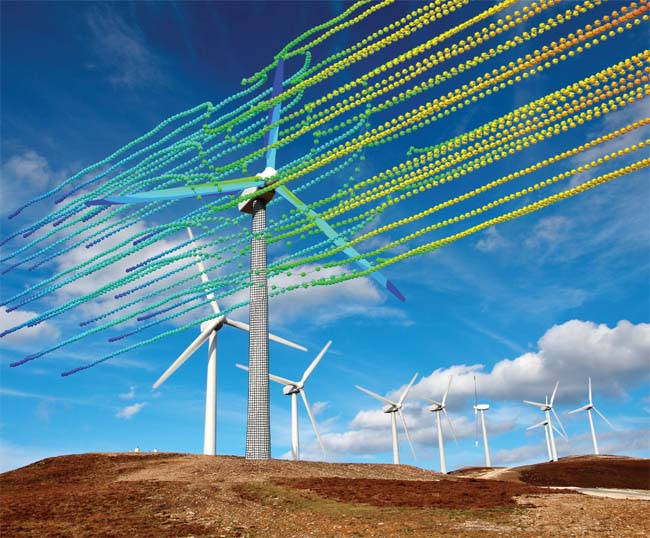 Wind-streams analyzed with NX Advanced Flow CFD software from Siemens PLM. Image courtesy Siemens PLM |
Capturing the Wind
Few landscapes are as surreal as that of a wind farm sporting thousands of white-bladed pylons for generating electricity. Companies that take on such building projects need to evaluate a myriad of operating factors, from evaluating blade shapes to determining just where to best site wind turbines. Blade design has traditionally been almost a hand-craft, with personal experience heavily weighting the chances for success, but now CFD software is improving both the designs themselves and the process to create them.
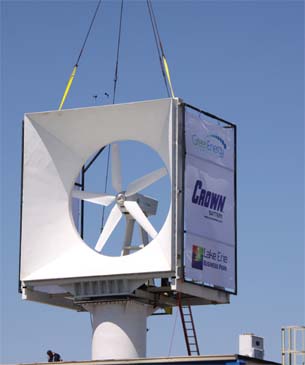 The shroud around a WindCube concentrates airflow per the Bernoulli Principle, increasing its velocity and therefore power for generating electricity. CFD analyses were done using CFdesign from Blue Ridge Numerics. The small footprint makes it suitable for urban use. Image courtesy GreenEnergy Technologies |
Two of Siemens PLM’s general-purpose tools, NX Advanced Flow and Femap Flow, let users analyze the air flow around turbine blades and offer a direct link between fluid and structural analyses. Rotating frames of reference simplify capturing blade motion, while boundary-layer meshing techniques resolve lift and drag effects close to the blade surface.
Remi Duquette, Director at MAYA HTT Ltd., uses NX tools for the company’s consulting business. He says, “With Synchronous Technology we can make quick changes in geometry and it triggers automatic CFD model changes. The new HD3D visual environment in NX also lets us easily communicate synthesized engineering results derived from the CFD and multiphysics composites structural analyses but delivered in the CAD context, which helps us efficiently guide the windmill blade design team.”
The engineering services team at CD-adapco recently applied its CFD expertise to demonstrate the validity of a revolutionary wind-turbine concept from the German company Windgiant. The compact design accelerates wind flow through a multi-bladed fan using several concentric aerodynamic shrouds and delivers energy at wind speeds as low 1.5 mps. Production units now in operation are working as predicted, generating high energy-per-unit-surface-area with low noise output—a system quite suitable for urban residential use.
Green Energy Technologies has tapped CFdesign software from Blue Ridge Numerics for the development of its unusual WindCube turbine system. Applying Bernoulli’s Principle, the WindCube uses a funnel-shaped shroud to capture and concentrate the wind, increasing the local velocity. This design produces more energy in a smaller footprint, making it suitable for urban areas.
In a third departure from classic wind turbines, designers at TFC Energy are working to capture low-speed winds (approximately 10 mph) using relatively short, curved panels mounted vertically. This contrasts to the traditional horizontally mounted blades high on pylons that work best at speeds from 18 to 20mph. Such a design works regardless of wind direction and therefore requires no expensive tracking system.
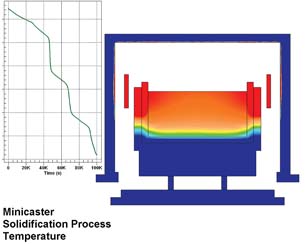 Algor software was used to simulate the casting process done by Solar Power Industries, which does research on making solar cells. SPI engineers performed an Algor steady coupled fluid-flow and thermal simulation to investigate the melting phase and adjust manufacturing parameters. Images courtesy Autodesk |
Until June of 2009, TFC Energy Chief Engineer Doug Bogart had been refining his designs based on test data gathered in the company’s wind tunnel. However, Dr. George Huang, a CFD expert at nearby Wright State University, recommended using SC/Tetra from Software Cradle. He explained that the software could handle a full 3D analysis and operate on parallel processors. This latter fact has been particularly helpful as the company has added more processors to its computer systems. User friendliness of SC/Tetra has also been a key feature, letting Bogart, new to CFD analyses, quickly come up to speed expediting the development process.
Hand in hand with the need for precise blade design is the siting task. Two of the biggest challenges in identifying prospective locations for wind farms are predicting wind power density across complex terrain and identifying local flow features likely to affect system durability. Vestas, a veteran Danish wind-turbine manufacturer, developed an automated methodology for this complicated task by wrapping a specialized application around CD-adapco’s STAR-CCM+ CFD code.
Having distilled the entire CFD process into essentially a push-button operation, the new STAR-CCM+ GUI allows any Vestas site engineer to produce a report detailing the suitability of a region for wind turbine deployment, including visualization of the flow field in Google Earth. Dennis Nagy, CD-adapco’s vice president for the Energy Industry, notes that previous wind-park simulations either oversimplified the physics or were too time consuming for realistic use. He adds, “(This) is paradigm changing—allowing large areas of terrain to be analyzed for twelve different wind directions in less than three hours, with little or no manual input.”
Two other approaches to wind-park layout design have involved CHAM’s PHOENICS CFD software. A third-party product from Windsim, powered by PHOENICS, helps users identify possible turbine locations with high wind speeds but low turbulence to maximize energy production. PHOENICS analyses have also been applied to determining micro-scale flow models that accommodate the flow details of such complex sites as steeply mountainous locations.
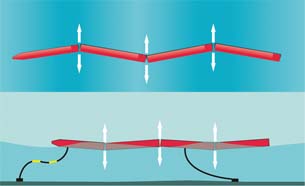 The Pelamis system deploys long, jointed metal segments that rock and roll with ocean movements to transfer wave-energy to generators. The company used Abaqus software from SIMULIA to model fluid-structural interactions. A second-generation system will go online offshore from the UK in 2010. Images courtesy SIMULIA |
Harnessing Water In Motion
Through the ages, flowing water has powered flour mills, paddleboats, and elaborate clocks. In more recent centuries, rivers have been the workhorses behind mammoth hydroelectric facilities around the world. Flow Science is one company whose clients have used its FLOW-3D software to simulate such large-scale movements as river diversion during dam construction. For the proposed Keeyask (Canada) Generating Station, engineers at Manitoba Hydro used FLOW-3D to verify flows on two different physical scale models. They found the simulation let them easily and quickly extract velocity, water level and flow rates anywhere within the CFD model domain, thanks to its turbulent mode and implicit pressure-velocity solver. Nested mesh blocks also supported detailed analysis where needed, yielding thousands more data points than could be measured from the physical model.
Waves, tides, and ocean currents form other relentless water sources. In recent years innovators have deployed dozens of mechanisms to convert their motion into electrical energy, and again CFD (along with fluid-structure interaction (FSI) studies) has played a critical role in each one. These mechanisms involve driving a pump, a piston, or a turbine, producing either mechanical motion or fluid pressure; the resulting approaches all look very different.
Manchester Metropolitan University in the UK has used Flow Science software for numerical modeling of a wave energy conversion device called WRASPA, a Wave-driven Resonant Arcuate-action, Surging Power Absorber (arcuate refers to a curved or bow shape). Flow Science’s FLOW-3D single-fluid model was used to model the response of the hinged collector mechanism to wave pitch motion. FLOW-3D does not require extra cells at the free surface, which reduced both setup and runtime. The software’s General Moving Object fixed mesh method proved to be compute efficient, particularly when used with the shared-memory parallel version of FLOW-3D.
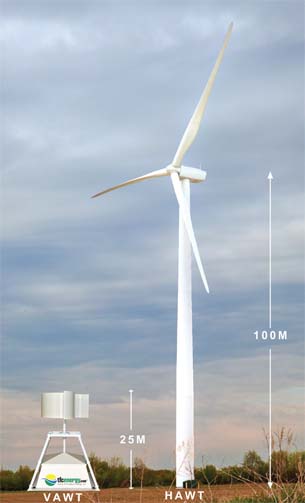 Size comparison of typical Horizontal Axis Wind Turbine (right) to a prototype Vertical Axis Wind Turbine (left). The latter systems, optimized for low wind-speed operation, are in development by Twenty First Century Energy (TFC Energy). The company used SC/Tetra V8 CFD software from Software Cradle to perform full 3D analyses of fluid flow fields. Image courtesy TFC Energy |
Advancing and optimizing designs to save energy is a core goal at Concepts NREC. This pioneer in the turbomachinery community offers a suite of software called Agile Engineering Design System, including PushButton CFD. Working with Oceanlinx, Concepts NREC is analyzing a set of 300kW-equivalent turbine generators based on oscillating water-column technology. Mark Anderson, Concepts NREC VP of software, says, “Our PushButton CFD product works in concert with our geometry generator AxCent. Its strength is in its tight coupling to ]this] geometry package parameterized for aerodynamic design.”
Wave-motion systems designers have also tapped other powerful CFD packages for performance analysis and optimization. Fred.Olsen Renewables has used NISA 3D FLUID from Cranes Software to study buoy-motion for its Olsen Wave Energy project. A unique project at Tidal Sails involves using CHAM’s PHOENICS CFD software to analyze the forces and movements of underwater sails as energy converters, where a string of such units are anchored at each end, with one end connected to a generator.
And Green Ocean Energy has identified ANSYS hydrodynamic and structural tools as critical to its product simulation efforts. The UK-based renewable energy company is developing two devices (Ocean Treader and Wave Treader) designed to bob on the surface of the ocean while floating “arms” convert wave motion into electricity via onboard generators (see DE December 2009).
Fueling Our Cars and More
We could dedicate an entire article to fuel cell design and the role that CFD analysis plays in designing these renewable energy systems fed with hydrogen. Two design forms currently of great interest are polymer exchange membrane fuel cells (PEMFC) and solid oxide fuel cells (SOFC)—the former appropriate for vehicles and the latter for generating stations.
PEMFCs have high power density and a relatively low operating temperature (from 140 to 176 degrees F). German researchers at FZ Julich chose ANSYS general-purpose Fluent software to analyze the flow in a PEMFC autothermal mixing chamber, which supplies the proper mixture of air, steam and evaporated fuel to the catalytic reaction zone. Fluent’s pressure-swirl atomizer model was well suited to modeling the process and helped identify areas with poor flow and insufficient heat exchange.
LMS International has developed a targeted LMS Imagine.Lab Fuel Cells simulation solution based on energy exchange validated by physical modeling. With this approach, users can model physical elements, test control strategies, and experiment with different materials and gases. The software handles single-cell stacks as well as entire fuel-cell systems.
In ESI Group’s CFD-ACE+ software, users have the choice of a full or simplified interface depending on the depth of simulation desired. The package can handle all the physics involved in fuel cell design, yet can be set up by analysts for designers to easily perform what-if studies.
|
A Blend of CFD, FSI & Multiphysics For many projects, CFD analysis plays a critical role in iterative design work involving multiphysics effects. Typical situations involve either fluid-structure interactions or fluid-thermal influences. Examples of work in the former area come from Capvidia. Its FlowVisionHPC software was used by the Portuguese consortium that built the first commercial wave-energy farm of articulated metal segments, dubbed Pelamis. Researchers at the University of Gent also used FlowVisionHPC to investigate fluid-structure interactions in a composite material buoy-power station, identifying stresses and predicting system lifetime as components slammed into water. The Gent group used the CFD package in conjunction with Abaqus FEA software from SIMULIA. Solar energy research, development, and commercialization includes a long history of tapping the power of CFD packages, such as those from Autodesk’s Algor and COMSOL. Solar Power Industries, a manufacturer of solar cells and related products, used Algor multiphysics software to perform a coupled fluid-flow and thermal simulation to optimize filling and heating their silicon ingot minicaster system. Being able to account for the effects of natural convection was critical to success. Researchers at the Fraunhofer Institute for Solar Energy Systems have been studying fluid dynamics in solar collectors made of heat-absorbing polymers instead of expensive metals. A full analysis must consider heat transfer due to fluid flow, heat-induced structural deformation/stress and, for some solar module structures, humidity. COMSOL software was the choice to incorporate all these tasks (see DE December 2009). SIMULIA’s Abaqus software has been used by the IDOM Group of Spain in concert with CFD analyses to quantify wind load levels on solar tracking systems. Another project assessed methods to protect offshore wind turbine towers against accidental impacts from small ships or boats using the fluid-filled equivalent of an automotive airbag to act as a “bumper.” Abaqus contains a specialized surface-based fluid-cavities capability that simplifies setting up the model for this analysis. —PJW |
Besides the wind applications mentioned above, CHAM’s PHOENICS software has been used to model flow combined with heat- and mass-transfer (including electrochemical reactions), such as for SOFC design. CD-adapco has also had customers use its STAR-CD package to perform fully three-dimensional CFD studies on SOFC stacks.
More Info:
ANSYS
Contributing Editor Pamela J. Waterman, DE’s simulation expert, is an electrical engineer and freelance technical writer based in Arizona. You can send her e-mail to [email protected].
Subscribe to our FREE magazine, FREE email newsletters or both!
About the Author
Pamela Waterman worked as Digital Engineering’s contributing editor for two decades. Contact her via .(JavaScript must be enabled to view this email address).
Follow DE





